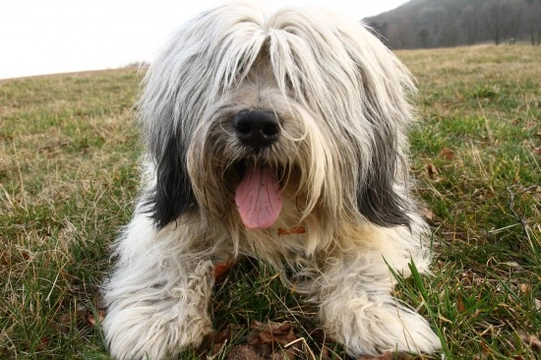Pets
Pets for studWanted petsBreedersAccessories & services
Knowledge hub
Support
Support & safety portal
Polish lowland sheepdog hereditary health and health testing
The Polish lowland sheepdog is a shaggy coated sheepdog breed that originates in Poland. They are medium sized, with males standing up to 20” tall at the withers and weighing up to 50lb, with females being slightly smaller. They are muscular, stocky and slightly rectangular in shape, due to the dense fur of the breed adding to their bulk. The tail of the breed is naturally short, and was historically docked even shorter before this procedure was outlawed within the UK.
The Polish lowland sheepdog has a very thick, shaggy coat that is double layered, with a dense, soft undercoat and a rough topcoat that can be either wavy or straight. The hair on the face grows particularly long, and may obscure the eyes if it is not trimmed or tied back.
The coat of the breed can be seen in virtually any colour and pattern distribution, but the most common colours are grey, white or brown, with markings in grey, black or brown. Puppies of the breed tend to be dark in colour, and their coats gradually lighten as they grow to their full length in adulthood.
If you are considering buying a Polish lowland sheepdog dog or puppy, it is important to do plenty of research into the breed before committing to a purchase. This includes finding out as much as possible about the hereditary health of the breed, their longevity, and any known health problems, which we will cover in more detail within this article.
Polish lowland sheepdog longevity
The average lifespan of the Polish lowland sheepdog is twelve years, which places the breed roundly in the middle of the average range across the board for all dog breeds of a similar size and build. The Polish lowland sheepdog is generally considered to be a robust, healthy breed, and not one that is particularly sickly or at a high risk of a wide range of health problems.
Genetic diversity
The coefficient of inbreeding statistic for the Polish lowland sheepdog is 10.8%, which indicates that the breed as a whole is subjected to a reasonable amount of inbreeding in order to keep the breed lines viable. While inbreeding is sometimes necessary in order to progress and develop the breed, breeders of the Polish lowland sheepdog are advised to reduce the coefficient of inbreeding statistic within their own breed lines where possible, aiming for the ideal of 6.25% or lower.
Conformation
The shape and build of the Polish lowland sheepdog is generally considered to be well balanced and not prone to exaggerations, but the long, thick coat of the breed can impede movement and vision and affect the dog’s quality of life if it is not properly maintained.
Regular brushing and grooming of the coat is essential, and care should be taken with dogs of the breed to ensure that they do not overheat in hot weather.
Health testing for the Polish lowland sheepdog
The British Veterinary Association and The Kennel Club have identified a hereditary propensity to certain health conditions within the Polish lowland sheepdog breed, which may affect the quality of life of dogs of the breed and potentially shorten their lifespans.
Testing for the following health conditions are advised for parent dogs of the breed, in order to ascertain if they are likely to make for healthy breeding stock:
- Hip score testing, with the breed’s mean hip score being 11.8. Potential parent dogs should receive a hip score below this figure in order to be considered as good parent dogs with healthy hips.
- Testing for retinal pigment epithelial dystrophy, an eye condition that requires annual testing.
- DNA testing for the bobtail gene, which can lead to an abnormally short tail.
Other health issues
While the Polish lowland sheepdog is generally considered to be a robust and healthy dog that is not prone to developing a wide range of health problems and hereditary illnesses, the conditions listed above are considered to pose a risk to the general health and wellness of the breed pool as a whole. As well as these, there are a few other health conditions that can affect the breed, but for which no pre-breeding screening is currently available.
These conditions are:
- Type one diabetes, due to an insufficient production of insulin within the body. This means that affected dogs will require supplementary insulin injections and regular blood sugar testing throughout their lives.
- Hypothyroidism, or an underactivity of the thyroid gland which leads to weight gain and lethargy. Supplemental hormone therapy may be required in order to manage this condition.
- Neuronal ceroid lipofuscinosis, a degenerative condition of the nervous system that leads to generalised weakness and a lack of coordination of the limbs.
- A low protein diet is also often recommended for the Polish lowland sheepdog, in order to provide balanced nutrition.



